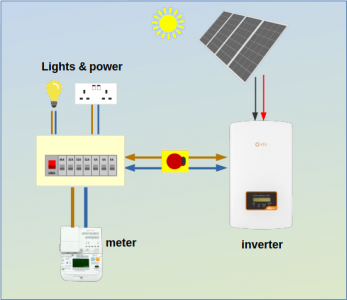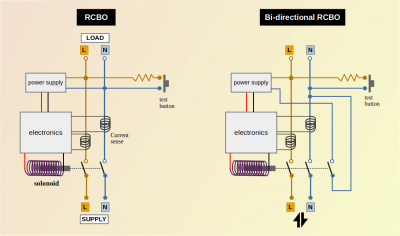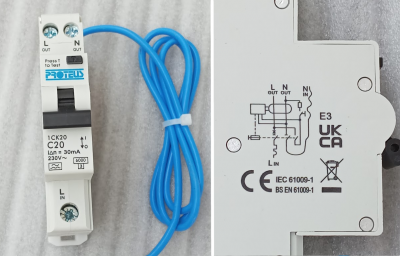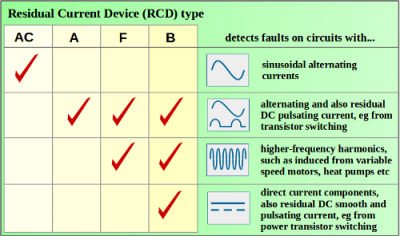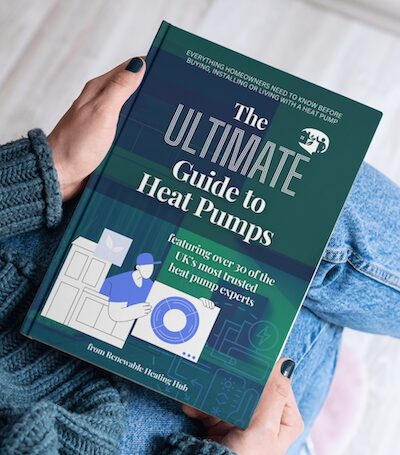Safety update; RCBOs supplying inverters or storage batteries
BEAMA have issued a safety update (March 2024) regarding the use of RCBOs to connect PV inverters or storage batteries.
This is not yet part of the IET Electrical Wiring Regulations, but it is sufficiently serious that an amendment is being expedited.
Overview: household electrical circuits are wired from a Consumer Unit which contains a number of trips.
Most trips are there to prevent excessive current being passed through wires/cables. Those are MCBs (Miniature Circuit Breakers).
It is common for a consumer unit to have one or more RCDs (Residual Current Detectors).
These compare the outgoing current on the Live wire, with that being returned on the Neutral.
If there is an imbalance, the contacts will open to prevent fire or electric shock to someone who has touched a live cable.
Increasingly, electricians are fitting RCBOs for individual power circuits.
These combine the functions of an MCB and RCD.
They will open the contacts either for over-current, or because current is leaking away somewhere.
If a single-circuit RCBO trips out, then at least the lights remain on so you can see what's gone wrong!
RCDs and RCBOs both have a test button.
This should be pressed periodically to check that it will open the contacts to protect against electric shock
When solar panels or storage batteries are installed, it is not mandatory that the circuit is supplied from an RCBO. An MCB is sufficient.
However, many installers do use an RCBO to provide an extra level of safety for when it might be necessary for an inverter to undergo maintenance.
Most Solar Inverters and Storage Batteries are "Grid tied".
They export to the mains supply through the same wires which connect them to the consumer unit.
A grid-tied inverter will have a G98 certificate, and requires permission from the regional DNO to install it.
This common arrangement means that electricity will pass through the RCBO in either direction.
The RCBO contains a small amount of electronics to handle the current sensing.
When there is a fault (either over-current or earth-leakage) a solonoid is energised (switched on), which opens the contacts.
If the RCBO was on a normal power circuit, opening the contacts would remove power from the electronics.
The trip would remain open until the lever was manually moved, and the solonoid would no longer be powered-on.
But if there is power still being applied in the reverse direction by an inverter or storage battery, when the contacts open, the solonoid remains energised.
Such a small solonoid will overheat and burn out.
The circuit can still be re-powered using the lever, but it will no longer be able to protect against electric shock.
The home owner won't know that.
The solution is to use a an RCBO specifically designed for bi-directional use.
A bi-directional RCBO has a third pair of contacts.
When the solonoid operates to open the trip, that 3rd contact set removes power from the electronics, and the solonoid coil is de-energised, preventing burn-out.
How can you tell if an RCBO is bi-directional?
Most RCBOs have arrows to show the direction of current, or have a label which denotes Supply and Load terminals.
A Bi-directional RCBO will not be marked for Supply and Load.
It may also have a set of arrows pointing in both directions.
If an RCBO isn't marked as being bi-directional, then it isn't.
The IET Wiring Regulations aren't retrospective.
When the amendment is released which specifies the need for a bi-directional RCBO, there will still be many thousands of installations which appear to have an operational RCBO, but it will only offer protection against over-current. It won't be acting to prevent fire or avoid electric shock.
It is up to forum members here to spread the word to others and advise that an existing RCBO is exchanged (by an electrician!) for a bi-directional type.
Save energy... recycle electrons!
This photo shows a bi-directional RCBO by Proteus at Redditch.
The symbols are correct, and the third-contact which the solonoid switches is visible in the diagram on the side.
What I still don't like is:
- the terminals being labelled 'In' and 'Out'
- no bi-directional symbol or marking on the part of the RCBO which remains visible to the householder after installation is completed
This particular RCBO is Type A
and Curve C... which defines the time it takes to trip due to over-current.
Most household MCBs and RCBOs are curve-B, which operates faster.
I use Curve-C trips to supply circuits which are likely to have large inductances connected (motors in a workshop or an inverter).
Update 28may24:
I have a response from Proteus Switchgear to say that they are already acting on the BEAMA directive and "will remove the in/out and also add on a bidirectional arrow symbol to the front of compliant devices"
The changes will filter through once existing stocks have been exhausted.
Save energy... recycle electrons!
- 26 Forums
- 2,340 Topics
- 53 K Posts
- 329 Online
- 5,998 Members
Join Us!
Podcast Picks
Latest Posts
-
RE: Configuration issues with 10kW Midea R32 heat pump
Sorry that was a screenshot of @curlyKatie - mine has...
By SteveT , 1 hour ago
-
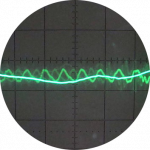
RE: Setback savings - fact or fiction?
As long standing followers of this debate will know, th...
By cathodeRay , 2 hours ago
-
RE: British Gas vs Octopus Energy vs Heat Geek vs EDF vs Aira vs OVO vs EON.Next vs Boxt
I get the impression that that comment "they don't comm...
By JamesPa , 5 hours ago
-

@majordennisbloodnok Just in case there are variations ...
By Toodles , 5 hours ago
-

RE: Latest NIBE model has known defect and no solution
@kings I’m glad I could help. NIBE are taking this very...
By Mars , 7 hours ago
-
RE: Octopus Cosy Heat Pump Owners & Discussion Thread
@jamespa yes, I'm under no illusions but in some respec...
By AndrewJ , 8 hours ago
-
RE: Poll for Time of Use, tariffs, technology
@majordennisbloodnok thanks. Unfortunately i can't upd...
By Tim441 , 11 hours ago
-

RE: The good, the bad and the not that great – my heat pump installation
It will be interesting to hear how you get on. Until re...
By cathodeRay , 11 hours ago
-
RE: Electricity price predictions
It seems the end of cfd payments is in sight, even if a...
By Batpred , 13 hours ago
-
-
@pie_eater Yes, I installed Homely to a Daikin heat pum...
By gery , 1 day ago
-
RE: Havenwise App Help & Forum Support – Get the Most from Your Heat Pump
@davidalgarve Potentially stupid question, but are you ...
By Sheriff Fatman , 1 day ago
-
RE: What a Bad Heat Pump Installation Looks Like
Spot on, for relatively little money, an air of ready "...
By Batpred , 1 day ago
-
RE: Replacing my 18 month old Hitachi Yutaki ASHP
@trebor12345 Ok that makes more sense and leads is i...
By JamesPa , 1 day ago
-
-

RE: Home energy storage & battery register
Now the proud owner of: 4.1Kw peak Aiko Neostar solar...
By TechnoGeek , 2 days ago
-
-
RE: Aira Heat Pump: Stylish Scandinavian Heating
Aira called me back today, but not sure we got to the a...
By ChandyKris , 2 days ago
-
RE: Experience with Mitsu Par 50/60 Wireless Controller
The 27°C request doesn't boost the weather compensation...
By Sheriff Fatman , 4 days ago


